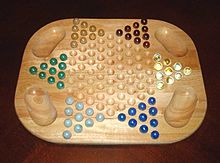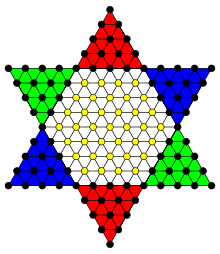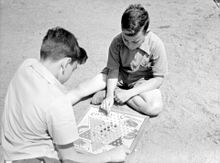Sternhalma
Sternhalma , also known as Trilma and internationally known as "Chinese Checkers", is a board game for up to six people. It is played on a star-shaped board, the Halmastern, but is derived from the original Halma , which is played on a square board. In Germany in particular, Sternhalma has established itself as the standard variant of the Halma game. Just like the classic Halma, Sternhalma is easy to learn and in principle also suitable for children, but requires practice to play it well.
history
The classic halma on a square game board was invented in 1883 by the American surgeon George Howard Monks . In 1892, Ravensburger registered a patent for a further development of the game on a hexagonal, star-shaped playing field as the Sternhalma, but the inventor is unknown. Above all, Sternhalma should allow three people to play.
After Sternhalma was sold in England from 1909 by JW Spear & Sons, initially with moderate success , the American Pressman Toy Corporation brought the game out in the United States as Hop-Ching Checkers in 1928 . The name was later changed to Chinese Checkers , probably to benefit from the great interest in East Asia at the time. The game gained great popularity in the United States and numerous companies released their own versions of the game under names such as Man dar-In , Mah Tong or Ching-Ka-Chek . The version from LG Ballard , which sold the game under the name Star Checkers , was particularly successful . In 1941 the Milton Bradley Company finally received a patent for the game. Nowadays games like Rubido still have similarities, but it has different levels of difficulty.
Because of the many triangles visible on the playing field, the game is also known as a trilma .
Style of play
Game board
The game board for Sternhalma can be played by 2 to 6 players, but was originally developed primarily for three players. Sternhalma does not differ from the classic Halma in terms of the aim and style of play, but is played on a star-shaped board consisting of six colored triangular points as start and finish fields and a hexagonal center area. The game board for Sternhalma has 121 fields arranged in a triangular grid, which together form the shape of the six-pointed star. Each field is adjacent to up to six other fields. Because, in contrast to the square halma, the fields are purely geometrically not surfaces, but points on a grid, there are 24 fields that form the edge of a house.
In addition to this version, other versions of the star plan can also be used, which for example only have 10 fields in the star points. In addition to flat game boards, there are also Halmastern fields on the market, where balls are placed in depressions as playing figures.
Rules of the game
At the beginning of the game, the playing figures are set up in the colored spikes, with the arrangement depending on the number of players. If there are two players, two opposing starting fields with 15 pawns each are set up. If there are three players, each player receives a starting field with 15 pawns, the opposing fields of the same color remain empty. If there are four or six players, each player is given a starting field opposite one opponent, but only places 10 pawns at a time, the innermost row remains free. Alternatively, 14 pieces can be used in a game of six, but then it is hardly possible to jump. With five players there is an asymmetrical game in which one player faces a free field while all the others face an opposing color.
The aim of the game in all variants is to move your own pieces into the opposite field with as few moves as possible. The players play in turn and each move a piece. The figures move from point to point within the network of lines, i.e. always diagonally forwards, diagonally backwards or sideways. The pieces may either be shifted one step to an adjacent free point along the connecting lines between the game points or other game pieces of your own color and those of a foreign color can be skipped over. The prerequisite for skipping is that there is a free space in a straight line behind the skipped figure. Several jumps can be made one after the other, if this is possible. This can result in long sequences of jumps and the best way to get to the finish line quickly is to create “ladders” along which the player can move several pins over long distances by jumping over them. The winner is the player who first has all of his pawns in the target field.
Game variants
As with most board games, there are also some variants of the standard game in the Sternhalma, which are collected in game collections and similar documentation. One of the simplest variants is the adoption of more than one color by each player in a two-player game so that a single player can support his own pieces with his second color. Team play is based on the same principle, in which in a game of four or six players, two players form a team and support each other. In team play, it can also be agreed that a player who already has his own pieces in the target field can support his partner during his turn.
The jumping straw is played according to the basic rules, but the jumping rule is changed. In this version it is allowed to jump over another figure from any distance, if you can land at the same distance behind it and no other figure is jumped over.
Other variants that are played according to the basic rules of moves and the rules of jumping on the star stalk board, but have completely different goals, are for example Gefangen and Connection . In Connection two to three players can participate. Each player receives 13 pawns and places them in his starting field so that the two inner corner fields remain free. The individual players do not face each other, so the opposite field remains free. The aim of each player is to form an uninterrupted line with their own playing pieces that connects any star point with another. Trapped is a blow game where the beginning of the game playing pieces 60 are placed in the interior space, the middle point remains free. The players now move and jump alternately with any figures and try to jump over as many other figures as possible. Skipped pieces are taken out of the field and collected, whoever has collected the most pieces at the end wins.
Sternhalma as a solo game
Halma can also be played as a solo game on the classic square straw board as well as on the star halma field. The player fills a starting field of the board with 15 pawns like in a game with several other players and tries to get his pawns into the target field with as few moves as possible. The rules correspond to the classic Halma game.
The Connection variant described above can also be played as a solo game.
More games on the star stalk plan
In addition to the games that are based on the classic rules of Halma, other games can also be played on the star stalk plan. The dice board game Rakado or Racado is one of the best-known games that are played on both the classic and the star stalk plan. In this game for two to three players, as in the Halmastern, the starting fields are filled with 15 pawns. The players also receive a game die and take turns rolling. The players then each move one piece in a straight line, but are not allowed to jump and must use the full number of points. If there is an opposing figure on the target field, it is captured and removed from the game. There is a compulsion to hit and a player who does not take this into account loses the piece with which he should have moved. The aim of the game is to get as many of your own pawns as possible undefeated into the opposite target field. Pieces that have arrived there may no longer be captured and can no longer capture.
Another game that uses a dice is car chase. This is similar to the Pachisi variants, but is played on the Sternhalma board. The players start each with a figure from a top spot on the game board and the players roll the dice in turn, starting with the player who threw the highest number at the time of the draw. The game pieces are drawn along the edge of the board according to the dice numbers; if the figure is one, the dice are rolled again. The aim is to catch up with the other players' pieces and to get back to your own starting field first. If a player reaches exactly the field on which an opposing playing figure is standing, this is captured and begins again from the respective starting point. The target point must be reached exactly, throws with a higher score expire.
supporting documents
- ^ A b c "Halma" In: Robert E. Lembke : The large house and family book of games. Lingen Verlag, Cologne, no date; Pp. 141-142.
- ↑ a b c d e Rodney P. Carlisle: Encyclopedia of Play in Today's Society, Volume 1, SAGE, 2009, p. 137
- ↑ a b c "Sternhalma." In: Erwin Glonnegger : The games book. Board and placement games from all over the world - origins, rules and history. New edition of Drei Magier Verlag, Uehlfeld 1999; Pp. 204-205. ISBN 3-9806792-0-9 .
- ↑ a b Halma ( Memento of the original from April 10, 2016 in the Internet Archive ) Info: The archive link was inserted automatically and has not yet been checked. Please check the original and archive link according to the instructions and then remove this notice. on geschicklichkeitsspiel.org; Retrieved April 9, 2016.
- ↑ a b c d "Halma to three" In: Erhard Gorys : The book of games. Manfred Pawlak Verlagsgesellschaft, Herrsching o. J .; Pp. 236-238.
- ^ "Halma to six" In: Erhard Gorys : The book of games. Manfred Pawlak Verlagsgesellschaft, Herrsching o. J .; Pp. 236-238.
- ↑ a b c d e f "Halma" rules and variants in a game manual from Schmidt Spiele. ( Full text )
- ↑ "Halma Solo" in a game manual from Ravensburger Verlag, p. 2. ( full text )
- ^ "Chase" in The Large Game Collection - Premium Edition by Schmidt Spiele, p. 3.





